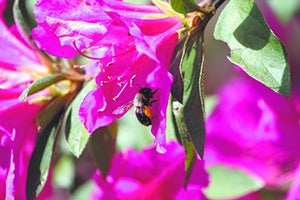Bees under threat
Published 7:31 am Friday, March 7, 2014

Honey bees, such as the one pictured, are natural pollinators of not just pretty flowers, but also perform an important function of pollinating food crops. Bees are under attack from many dangers, including colony collapse disorder, Varrora Mites and small hive beetles.
Bees face a number of dangers, including colony collapse disorder in addition to the invasive small hive beetle and Varrora Mite, according to county resident and beekeeper L.E. Smith.
Bees are an important part of nature; they pollinate plants including the crops people eat. Without them, flowering plants would not produce fruit and vegetables and therefore seeds for subsequent generations.
Smith has been a beekeeper for more than 45 years, and has seen beekeeping methods evolve from the bee gum hive, a hollow tree, to the moveable frames used today. Smith said moveable frames are used by some beekeepers to migrate bee colonies for crop pollination, although he does not participate in that industry.
He uses the movable frame as a home for his hives because they open easily, allowing him to inspect the hive.
Smith said he had about nine hives, until the recent freeze in January killed six. During extremely cold weather, such as what was seen early this year, bees will form a ball to create an insulated shield. The bees on the outer ring of the ball will die, but ensure the bees inside survive. The larger the hive the more bees survive during a freeze, he said. Once the weather warms surviving bees will carry the dead out of the hive.
Even though he lost more than half of his hives, he said he plans to repopulate the hives once the weather warms. He has three methods to accomplish this, split his existing hives into the empty ones, collecting wild hives or rearing a new queen.
Queens are the larger bees in a hive who produce offspring. Smith said he is trained in queen rearing.
“That in itself is a different process,” Smith said.
Smith asks anyone with unwanted hives around their home to call him so he can collect and care for them by adding them to his hives.
Smith is also a member of the Mississippi Bee Keepers Association, Louisiana Bee Keepers Association and American Honey Producers Association.
The threats bees face also pose a threat to the availability of crops to humans. Smith said without bees to pollinate crops, food production will suffer.
A couple of things people may not know about honey, the food bees produce for themselves, is that it has antiseptic properties and an indefinite shelf life, so long as it does not come into contact with water. Water causes the honey to ferment, Smith said.
Prior to the early 1980’s most bees were feral, or lived without human interaction. Now, Smith estimates about 95 percent of all hives are under beekeeper care.
To ensure bees thrive into the future Smith said a few states are conducting research into colony collapse, and protecting bees from Varrora Mites and small hive beetles.



